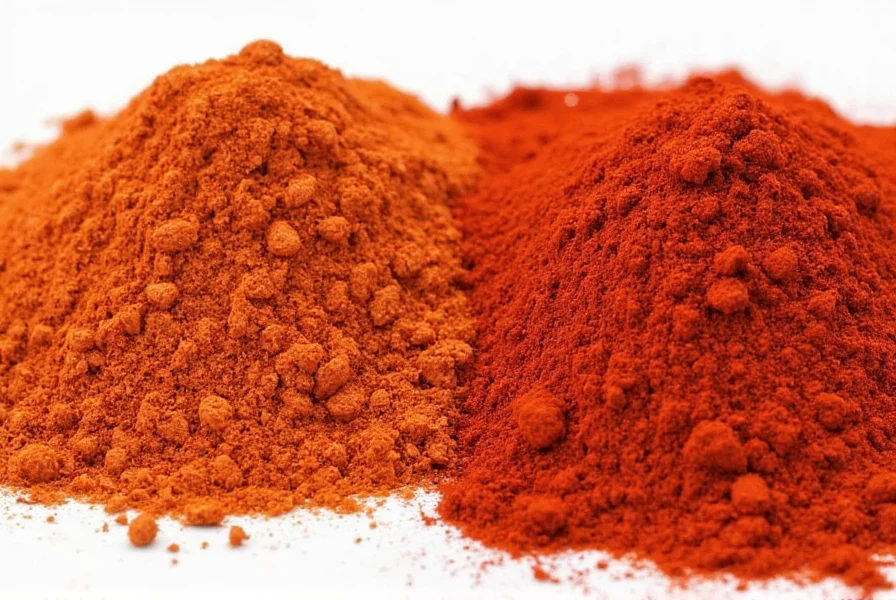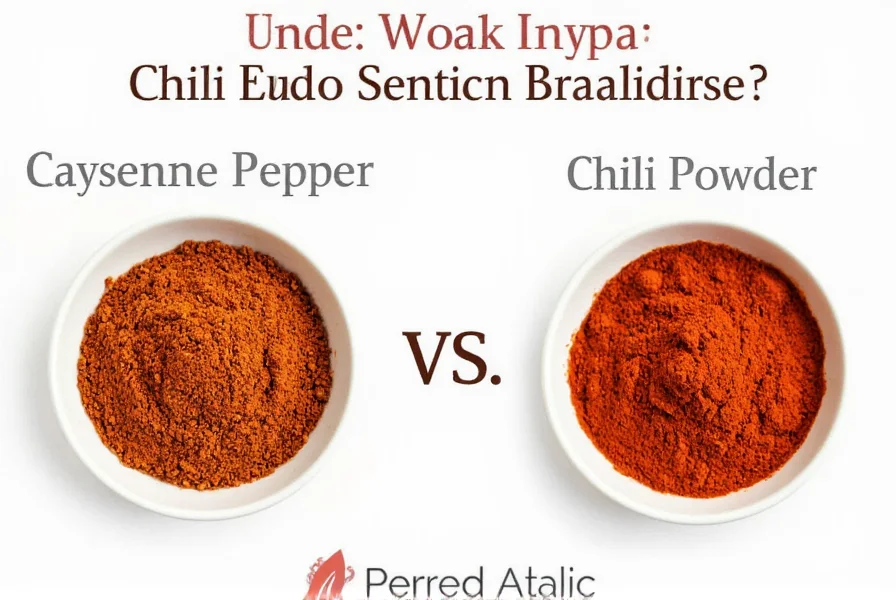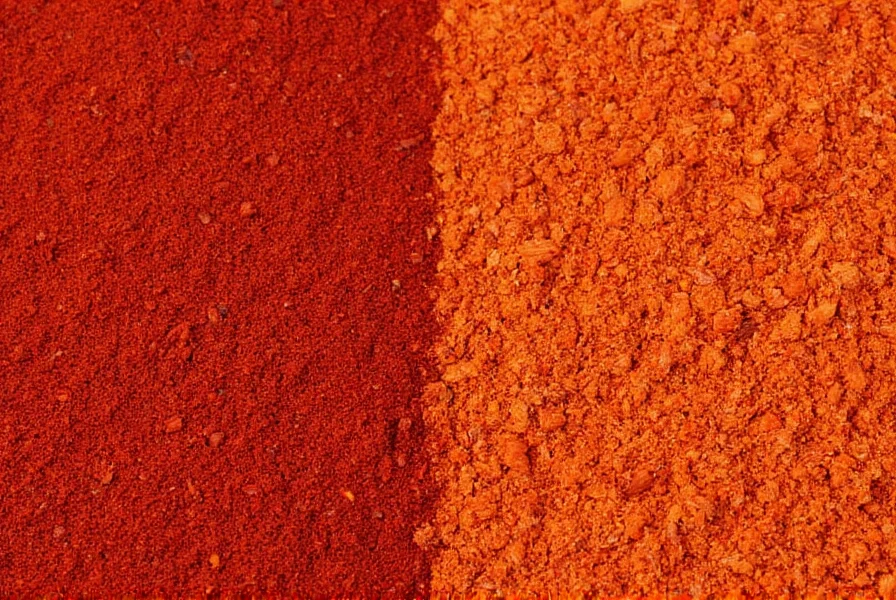Understanding the distinction between cayenne pepper and chili powder is essential for home cooks and culinary enthusiasts who want to achieve authentic flavors in their dishes. Many recipes specify one or the other, and using the wrong spice can dramatically alter your dish's flavor profile and heat level. This comprehensive comparison explores their composition, heat levels, flavor characteristics, and best culinary applications to help you make informed choices in your kitchen.
What Exactly Are These Spices?
Cayenne pepper comes from specific varieties of Capsicum annuum peppers that are dried and ground into a fine red powder. It's a single-ingredient spice with consistent heat properties. True cayenne pepper contains nothing but ground cayenne peppers, though some commercial versions may include anti-caking agents.
Chili powder, despite its name, is actually a spice blend. In the United States, commercial chili powder typically contains ground chili peppers along with cumin, garlic powder, oregano, and paprika. The specific blend varies by manufacturer, which explains why heat levels and flavors differ between brands. Mexican-style chili powder often contains only ground chilies without additional spices.
Heat Level Comparison
The most significant difference between these spices lies in their heat intensity. Cayenne pepper consistently ranks between 30,000-50,000 SHU on the Scoville scale, placing it in the 'hot' category. For reference, this makes cayenne approximately 12-20 times hotter than a typical jalapeño pepper.
| Spice | Scoville Heat Units | Heat Level Description |
|---|---|---|
| Cayenne Pepper | 30,000-50,000 SHU | Intense, immediate heat with some fruity undertones |
| Standard Chili Powder | 500-5,000 SHU | Mild to moderate heat with complex flavor notes |
| Mexican Chili Powder | 1,000-10,000 SHU | Moderate heat with earthy, smoky characteristics |
Chili powder's heat varies significantly based on the blend. Standard American chili powder usually measures between 500-5,000 SHU, making it considerably milder than cayenne. Mexican-style chili powder, which contains only ground chilies, can range from 1,000-10,000 SHU depending on the specific chili varieties used.
Flavor Profile Differences
Cayenne pepper delivers a straightforward, intense heat with subtle fruity and slightly bitter notes. It lacks the complexity of spice blends because it contains only one ingredient. When using cayenne, you're primarily adding heat rather than layered flavors.
Chili powder offers a more complex flavor profile due to its blend of ingredients. Most American chili powders include:
- Ground ancho or New Mexico chilies (providing base heat and flavor)
- Cumin (earthy, warm notes)
- Garlic powder (savory depth)
- Oregano (herbal notes)
- Paprika (color and mild sweetness)
- Salt (in some blends)
This combination creates the characteristic flavor associated with chili con carne and other Southwestern dishes. The additional spices in chili powder contribute significantly to the overall flavor of dishes beyond just heat.

Culinary Applications
Understanding when to use each spice can transform your cooking. Cayenne pepper works best when you need pure, unadulterated heat without additional flavors. Professional chefs often use cayenne in:
- Cajun and Creole seasoning blends
- Hot sauces requiring consistent heat
- Marinades where other flavors might overpower
- Seafood dishes needing subtle heat enhancement
- Egg dishes for a spicy kick
Chili powder shines in recipes where complex flavor development matters more than intense heat. It's essential for:
- Authentic chili con carne
- Taco seasoning and fajita mixes
- Southwestern-style stews and soups
- Barbecue rubs and sauces
- Bean dishes requiring depth of flavor
Substitution Guidelines
When substituting one for the other, consider both heat level and flavor profile. For recipes calling for cayenne pepper:
- Use 1/4 to 1/2 teaspoon chili powder for every 1/8 teaspoon cayenne (adjust to taste)
- Add additional cumin or paprika to compensate for missing flavors
- Be aware that the dish will have more complex flavors but less intense heat
For recipes specifying chili powder:
- Use 1/8 teaspoon cayenne plus 3/4 teaspoon paprika for every 1 teaspoon chili powder
- Add 1/4 teaspoon cumin and a pinch of garlic powder
- Start with less cayenne and adjust gradually to avoid overpowering heat

Nutritional Comparison
Both spices offer health benefits, though their nutritional profiles differ due to composition. Per teaspoon (2g):
| Nutrient | Cayenne Pepper | Chili Powder |
|---|---|---|
| Calories | 6 | 7 |
| Vitamin A | 44% DV | 19% DV |
| Vitamin C | 3% DV | 2% DV |
| Iron | 3% DV | 4% DV |
| Capsaicin | High concentration | Variable, generally lower |
Cayenne contains higher concentrations of capsaicin, the compound responsible for chili heat that also offers potential metabolic benefits. Chili powder provides more varied nutrients due to its additional spice components, particularly if it contains cumin which adds iron and other minerals.
Storage Recommendations
Both spices lose potency over time but require similar storage conditions. For maximum shelf life:
- Store in airtight containers away from light and heat
- Keep in a cool, dark cupboard (not above the stove)
- Replace whole dried chilies every 1-2 years
- Ground spices maintain potency for 6-12 months
- Freeze whole dried chilies for up to 2 years
Test potency by smelling the spice. Fresh cayenne should have a sharp, pungent aroma, while fresh chili powder should smell earthy and complex. If the scent is faint, the spice has likely lost significant flavor and heat.
Common Misconceptions
Several myths persist about these spices that can lead to cooking mistakes:
- Misconception: Chili powder and cayenne pepper are interchangeable without adjustment
Reality: Their heat difference is substantial—cayenne is typically 6-10 times hotter than standard chili powder - Misconception: All chili powders contain cayenne
Reality: Most American chili powders use milder chilies like ancho or New Mexico peppers - Misconception: Red pepper flakes and cayenne pepper are the same
Reality: Red pepper flakes contain multiple chili varieties and have texture differences
Final Recommendations
When deciding between cayenne pepper vs chili powder for your recipe, consider whether you need pure heat or complex flavor. Keep cayenne in your pantry for when you want straightforward spiciness without additional flavors. Maintain chili powder for Southwestern and Mexican-inspired dishes where the blend of spices creates authentic flavor profiles. Serious cooks often keep both on hand to achieve precise control over both heat and flavor in their cooking.











 浙公网安备
33010002000092号
浙公网安备
33010002000092号 浙B2-20120091-4
浙B2-20120091-4